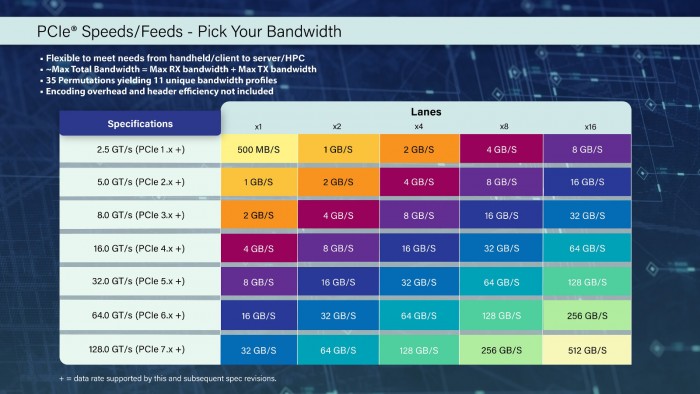The PCIe 7.0 specification is designed to support emerging applications such as 800 G Ethernet, AI/ML, cloud and quantum computing; and data-intensive markets such as hyperscale data centers, high-performance computing (HPC) and military/aerospace.
After completing the specification of PCIe 6.0, PCI-SIG announced the new plan for PCI Express 7.0 on Tuesday. If all goes well, the new specification will be officially launched in 2025. Although PCIe 5.0 is still in the popularization stage, PCIe 7.0 in the future can support 128 GT/s @ x16 interface configuration and up to 512 GB/s bidirectional transmission.

The following are the key features of the PCIe 7.0 specification:
● Provides 128 GT/s and 512 GB/s bidirectional transfers in a x16 configuration.
● Using PAM4 pulse amplitude modulation signaling
● Pay attention to channel parameters and ranges
● Further reduce latency and improve reliability
● Improve energy efficiency
● Compatible with all previous PCIe versions

"PCI-SIG clocks have been built this way for 30 years," said Nathan Brookwood, a researcher at Insight 64.
Early parallel versions of PCI technology had transfer rates of only a few hundred MB/s, which matched the graphics, storage, and networking needs of the 1990s.
In 2003, the PCI-SIG pushed for a transition to serial designs supporting thousands of MB/s (several GB/s) to accommodate higher-speed solid-state disks and Ethernet connections.
After tightening its spring, PCI-SIG doubles the bandwidth of the PCIe specification almost every three years to actively respond to the challenges of emerging applications and markets.
Today's newly announced PCIe 7.0 doubles the channel speed to a bidirectional 512 GB/s, continuing the goal of doubling the performance of the PCIe specification within another three-year cycle.
Previous article:my country has declared 18,000 5G standard essential patents
Next article:Bluetooth SIG announces completion of LE Audio specification and introduction of Auracast broadcast audio
Recommended ReadingLatest update time:2024-11-15 06:01





- Keysight Technologies FieldFox handheld analyzer with VDI spread spectrum module to achieve millimeter wave analysis function
- Qualcomm launches its first RISC-V architecture programmable connectivity module QCC74xM, supporting Wi-Fi 6 and other protocols
- Microchip Launches Broadest Portfolio of IGBT 7 Power Devices Designed for Sustainable Development, E-Mobility and Data Center Applications
- Infineon Technologies Launches New High-Performance Microcontroller AURIX™ TC4Dx
- Rambus Announces Industry’s First HBM4 Controller IP to Accelerate Next-Generation AI Workloads
- NXP FRDM platform promotes wireless connectivity
- WPG Group launches Wi-Fi 7 home gateway solution based on Qualcomm products
- Exclusive interview with Silicon Labs: In-depth discussion on the future development trend of Bluetooth 6.0
- Works With Online Developer Conference is about to start, experience the essence of global activities online
- LED chemical incompatibility test to see which chemicals LEDs can be used with
- Application of ARM9 hardware coprocessor on WinCE embedded motherboard
- What are the key points for selecting rotor flowmeter?
- LM317 high power charger circuit
- A brief analysis of Embest's application and development of embedded medical devices
- Single-phase RC protection circuit
- stm32 PVD programmable voltage monitor
- Introduction and measurement of edge trigger and level trigger of 51 single chip microcomputer
- Improved design of Linux system software shell protection technology
- What to do if the ABB robot protection device stops
- CGD and Qorvo to jointly revolutionize motor control solutions
- CGD and Qorvo to jointly revolutionize motor control solutions
- Keysight Technologies FieldFox handheld analyzer with VDI spread spectrum module to achieve millimeter wave analysis function
- Infineon's PASCO2V15 XENSIV PAS CO2 5V Sensor Now Available at Mouser for Accurate CO2 Level Measurement
- Advanced gameplay, Harting takes your PCB board connection to a new level!
- Advanced gameplay, Harting takes your PCB board connection to a new level!
- A new chapter in Great Wall Motors R&D: solid-state battery technology leads the future
- Naxin Micro provides full-scenario GaN driver IC solutions
- Interpreting Huawei’s new solid-state battery patent, will it challenge CATL in 2030?
- Are pure electric/plug-in hybrid vehicles going crazy? A Chinese company has launched the world's first -40℃ dischargeable hybrid battery that is not afraid of cold
- Automatic air conditioning comes in
- BlueNRG LP turned off radio, app not working?
- Solution to CCS8.1.0 not finding .h files
- Analysis of the characteristics, advantages and potential applications of 60GHz wireless technology
- Looking for the design of station signal simulation control system
- EEWorld invites you to attend the 2019 STM32 Summit and Fan Carnival!
- A brief introduction to the internal structure of photoelectric sensors
- Geek Black Technology, Shopping Carnival | Here are the deals you can’t miss!
- I need help from an expert. "When designing a microcontroller hardware circuit using STC89C51, should I design the EEPROM circuit part?"
- Claiming that software is open source when it is not is false advertising

 Embedded high-speed serial bus technology - implementation and application based on FPGA
Embedded high-speed serial bus technology - implementation and application based on FPGA
















 京公网安备 11010802033920号
京公网安备 11010802033920号